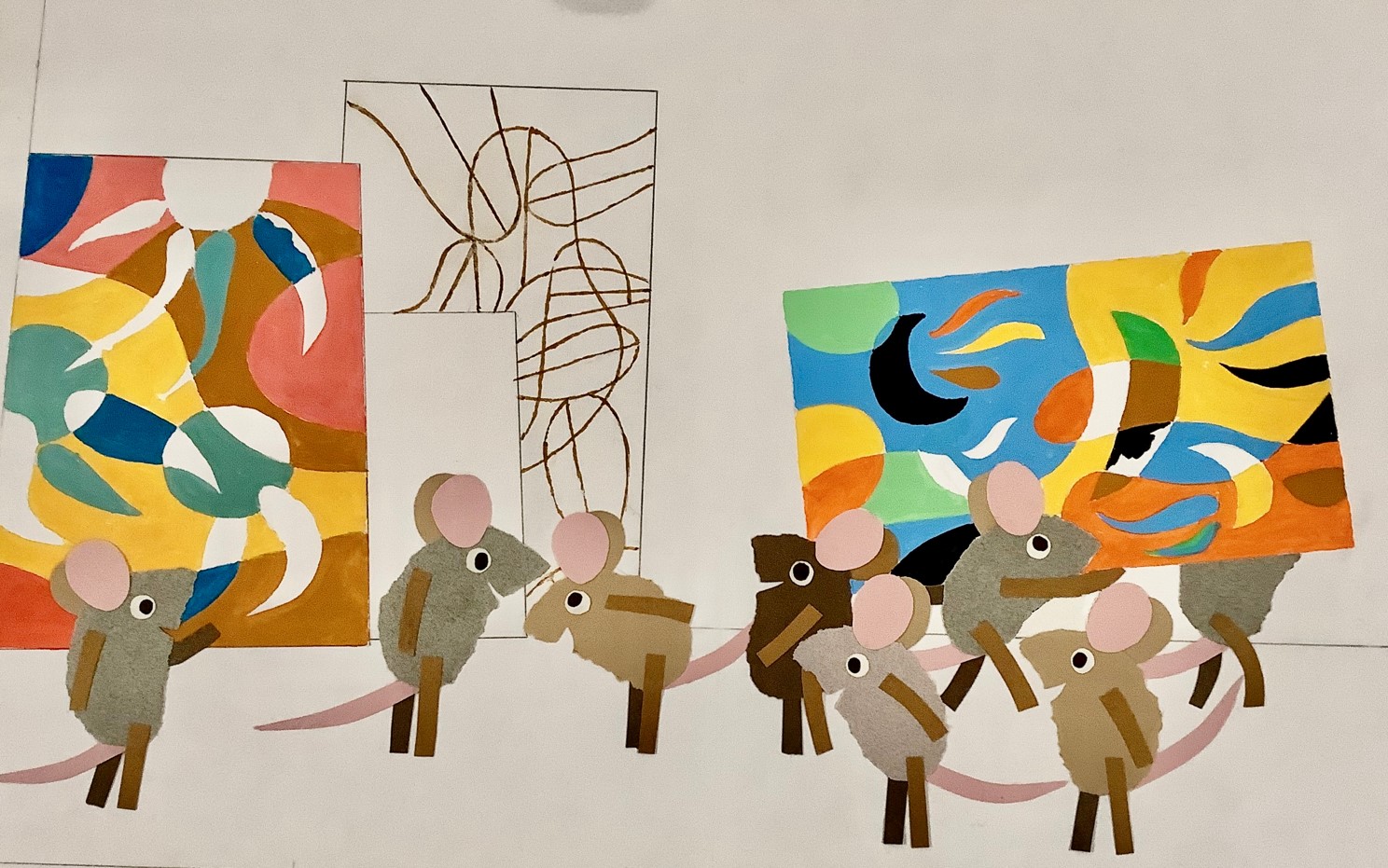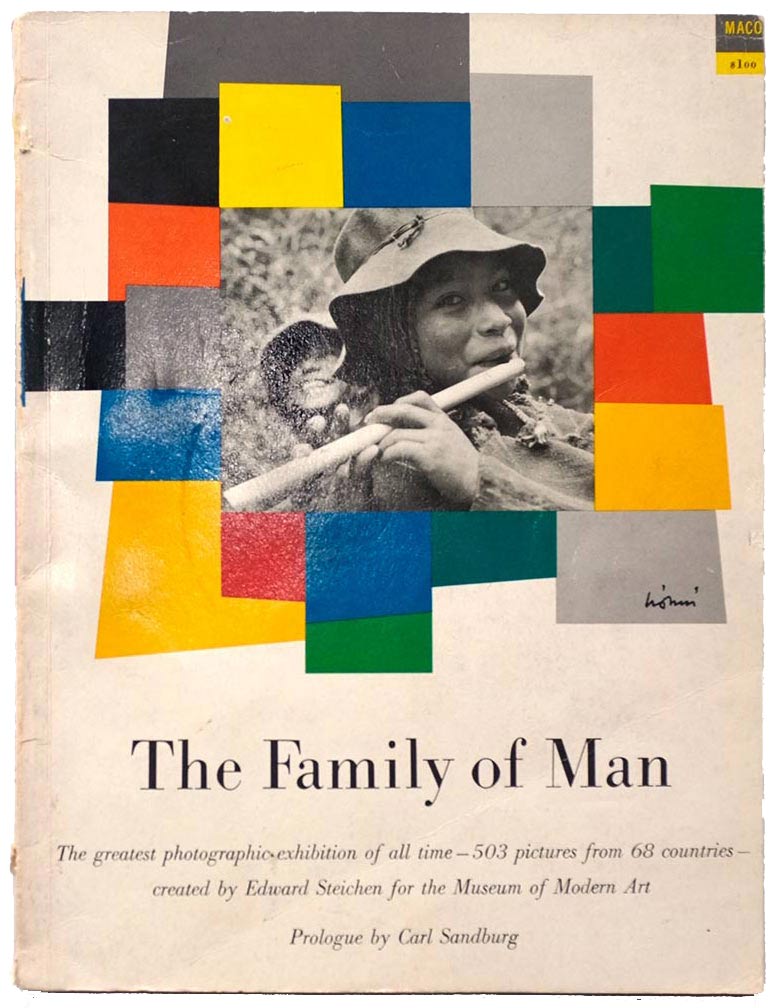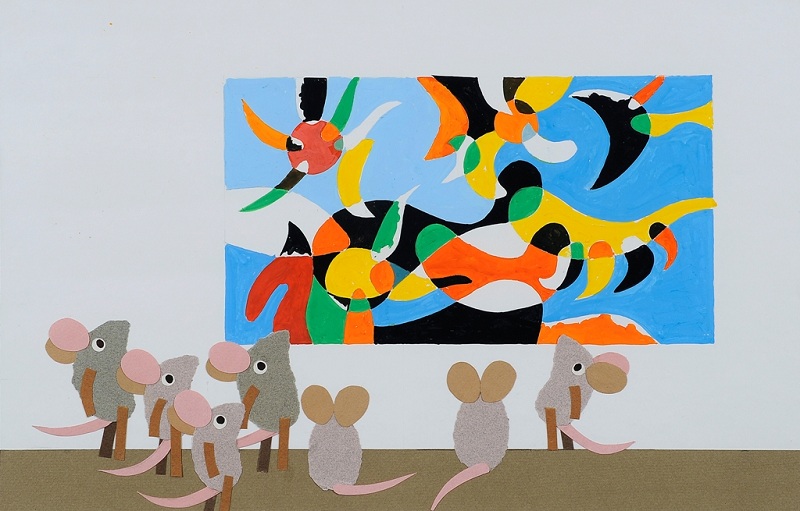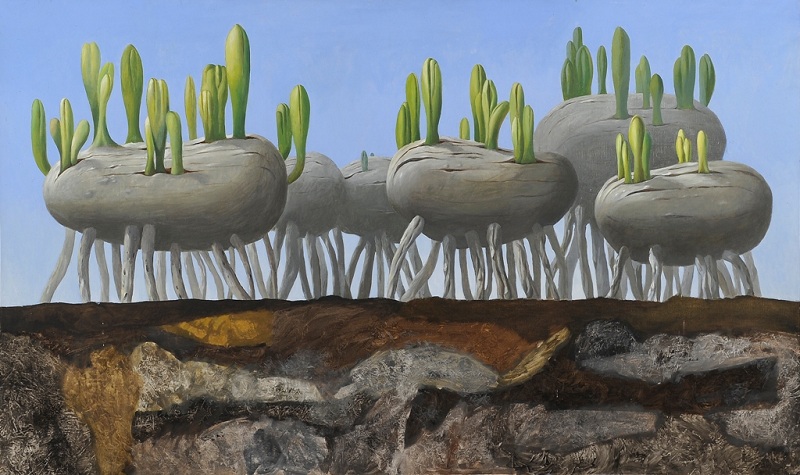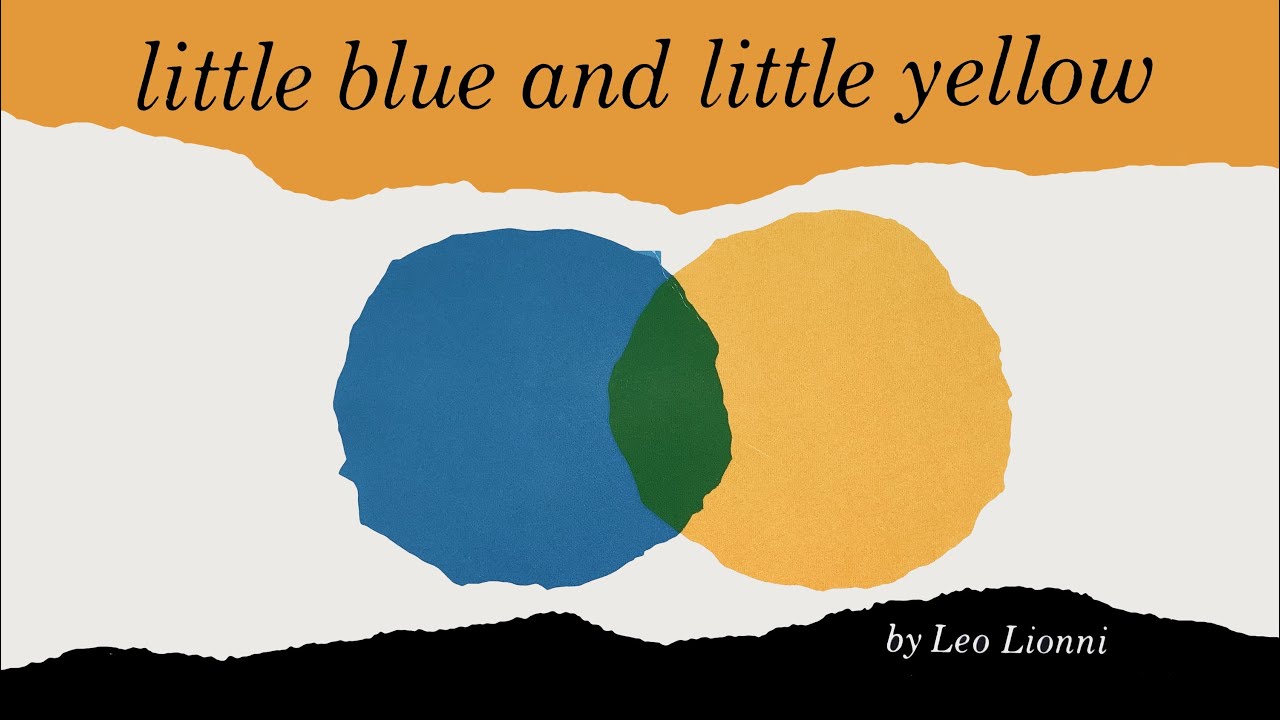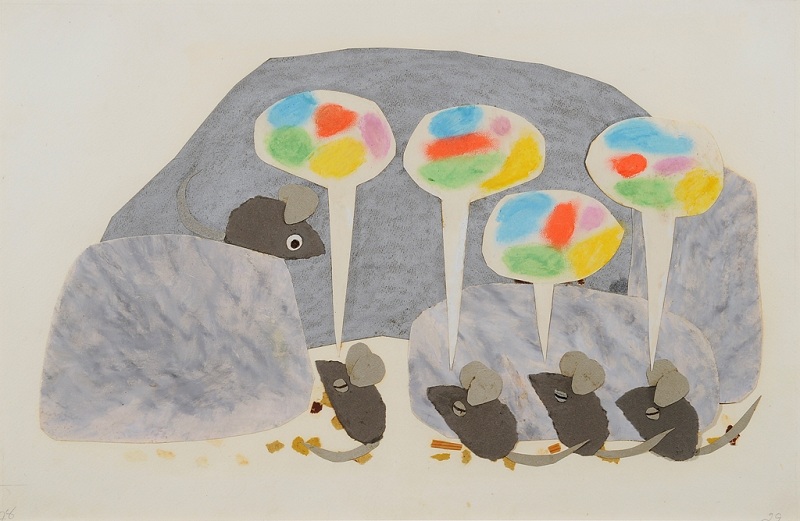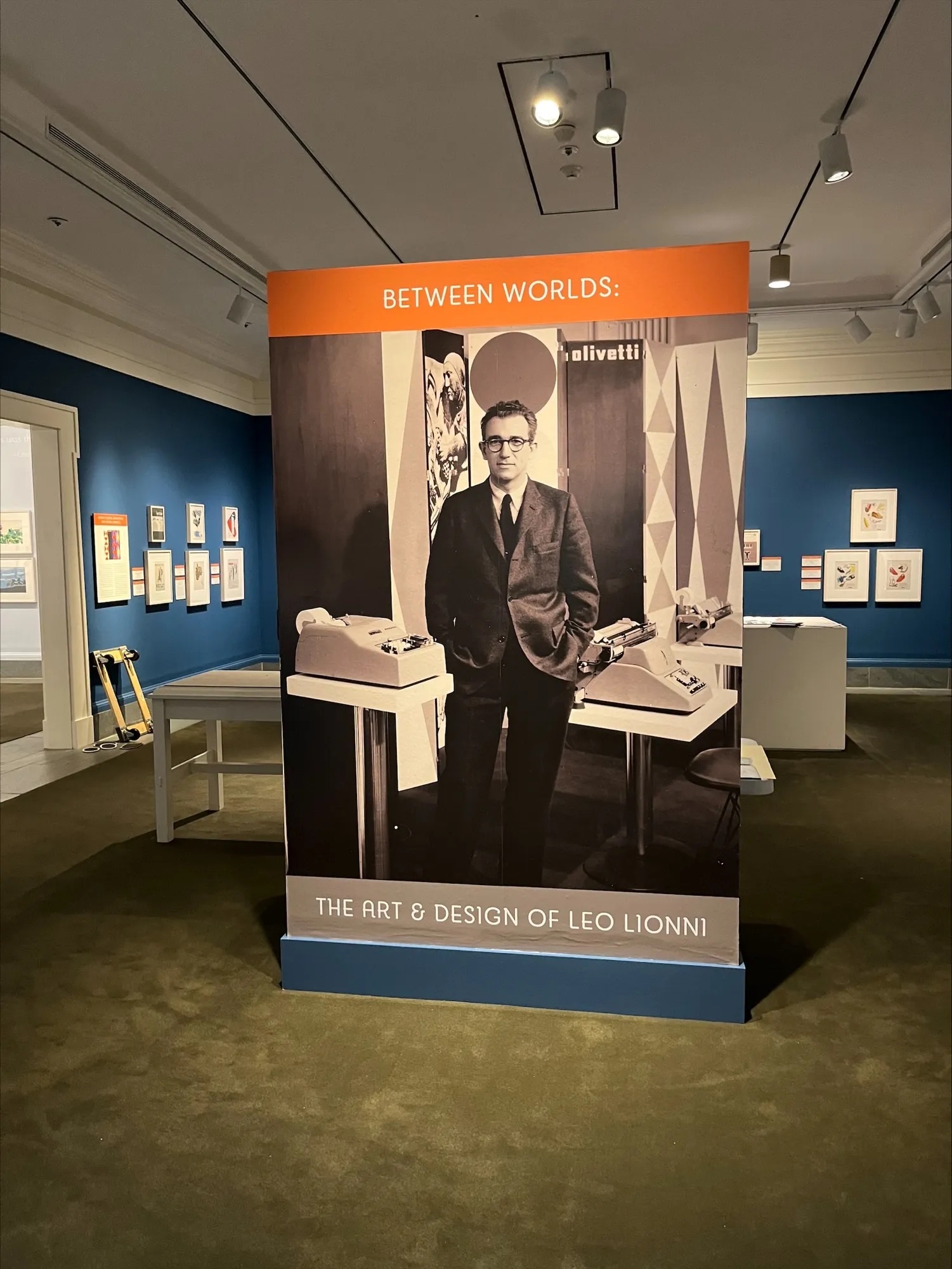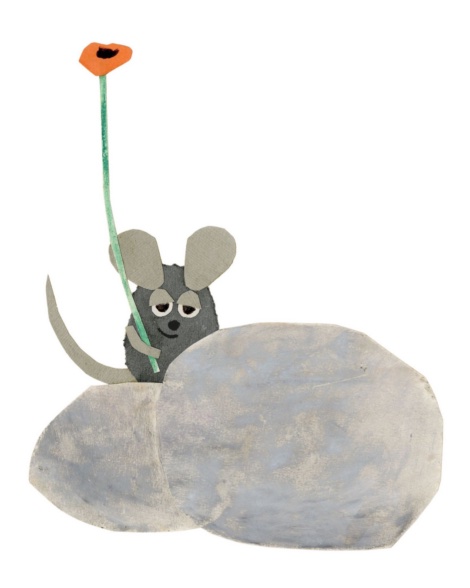BETWEEN WORLDS: The Art and Design of Leo Lionni
November 18, 2023 to May 27, 2024
Between Worlds: The Art and Design of Leo Lionni is the first major American retrospective dedicated to the art and design work of groundbreaking modernist designer and children’s book illustrator Leo Lionni (1910-1999). “Design is form,” the artist said, “Sometimes it is decorative form, and has no other function that to give pleasure to the eye. Often it is expressive form, related to conceptual content, to meaning. It is always abstract; but like a gesture or a a tone of voice it has the power to command and hold attention, to create symbols, to clarify ideas.” Together with Chief Curator Stephanie Haboush Plunkett, the exhibition is co-curated by author and children’s book historian Leonard Marcus and illustration and design historian Steven Heller. The Museum is also working closely with Annie Lionni, the artist’s granddaughter.
As the old distinction between fine and applied art came up for lively reconsideration after the Second World War, Leo Lionni emerged as one of the international design community’s indispensable pathfinders and bridge-builders. Idealistic and globally minded, Lionni viewed pithy, smart, deceptively simple graphic design as a worthy contribution to the post-war effort to reassert democratic values and establish a visual lingua franca to unite people across generations and cultural boundaries. A kind of twentieth-century Leonardo, he pursued his creative vision across several related domains, each of which will be explored in depth in this exhibition, including graphic design and advertising art; his art direction at Fortune and Print magazines; the creation of forty children’s picture books; and personal works including printmaking, photography, drawing, painting, and sculpture.
“[I feel] an irresistible urge to make things.”
⸺Leo Lionni
VISIONARY DESIGNER
Offering a compelling glimpse of Italian American artist Leo Lionni’s early life in Amsterdam, Brussels, and Genoa, Between Worlds invites the exploration of his first inspirations, including the terrarium from his childhood bedroom that heralded the beginning of his lifelong fascination with natural forms, influencing the look and proportions of his picture books. A section on graphic design will highlight key examples of Lionni’s innovative freelance work for Olivetti, Container Corporation of America, Ford Motor Company, the American Cancer Society, the Ladies’ Home Journal’s Never Underestimate the Power of a Woman” campaign, the prototype issue of Sports Illustrated, and the Museum of Modern Art, including his poster for MoMA’s 25th anniversary and work for the Family of Man exhibition curated by Edward Steichen. Noted graphic designer, author, and historian Steve Heller, the Co-Curator of this exhibition, observed in Print’s column, The Daily Heller: “Lionni believed that formal precepts could be applied to virtually any advertisement. But this is not a “how-to,” it is a “Hey, what’s this?” When was the last time a promotion piece to sell advertising asked aesthetic and formal questions? I wonder whether clients today would understand it. I doubt that any publication today would invest in such an abstract idea.”
PROVOCATIVE ART DIRECTION
Lionni’s work as the art director at Print (1955-1956) and Fortune (1948-1960) will be explored. In addition to designing striking covers and interior layouts he was instrumental in launching the careers of many younger artists and designers, including celebrated picture book artist Eric Carle. This pivotal section looks at the “Unfinished Business” exhibition that Lionni designed for the United States Pavilion of the 1958 Brussels World’s Fair, which gave a frank account of the struggle for racial justice in 1950s America. Visitors from around the world appreciated the installation’s honesty about the United States’ ongoing efforts to live up to its ideals, but pressure from southern politicians shut down the exhibit long before the fair’s end. As Annie Lionni has aptly noted, her grandfather created his first children’s book one year later. She sees this as his way of “finishing the business” that had been interrupted in Brussels: Little Blue and Little Yellow and the many picture books that followed were all about community building, problem solving, and striving for a better world. The collage elements of Lionni’s graphic design images became visual building blocks in the realization of that better world on the pages of a book that an open-minded four-year-old could both enjoy and learn from.
CLASSIC MODERNIST PICTURE BOOKS
Original art and preliminary drawings for several of Lionni’s most notable children’s picture books will be on view, including Frederick, Inch by Inch, Pezzettino, Matthew’s Dream, and others, which have been published in foreign-language editions around the world. The Aesop of our time, Lionni was a fabulist and philosopher who brought unexpected psychological and moral depth to the picture book while working within the visual idiom he shared with such post-war International style designers as Paul Rand, and Eero Saarinen, Charles and Ray Eames. The artist’s granddaughter Annie Lionni, who is a collaborator on this exhibition, notes that Lionni began creating children’s books in “his retirement years.” “The traditional story of how Leo came to write his first book for children involves my brother, Pippo, and me in 1959. At the time, Leo was an art director at Time Life, and he took us on the commuter train out of Grand Central Station in New York to spend the weekend with him and our grandmother, Nora, in Greenwich, CT. He entertained us by tearing colored paper from a magazine that he had in his briefcase to create the story of Little Blue and Little Yellow. The positive response we gave to his story was enough to inspire him to recreate it with some construction paper in his studio at home. His friend, Fabio Coen, who later became an editor at Pantheon Books, saw the mock-up over the weekend and they decided to publish Little Blue and Little Yellow.” Lionni’s literary legacy includes four Caldecott Honors for excellence in illustration as well as dozens of other prizes, an elementary school curriculum based on his books described in Vivian Gussin Paley’s The Girl with the Brown Crayon, inclusions in best books lists, and countless praise from teachers, librarians, parents, and children.
IMAGINED WORLDS: PARALLEL BOTANY
“Parallel Botany” is the fully elaborated fantasy plant world that Lionni created over a period of years in a variety of media: drawings, prints, bronze sculptures, paintings, and an illustrated artist’s book. These imaginative works circle back to the home terrarium that sparked his childhood love of nature and will serve as a final statement of Lionni’s belief in the importance of embracing nature while also feeling free to re-imagine the world as we find it.
BETWEEN WORLDS EXHIBITION CO-CURATORS
Steven Heller is the co-chair of the School of Visual Arts MFA Design / Designer as Author + Entrepreneur program and of the SVA Masters Workshop in Rome. He wrote the “Visuals” column for the New York Times Book Review, where he also had a distinguished career as the Book Review’s art director. He has written a weekly column for The Atlantic online and currently writes The Daily Heller / Imprint online. He has written more than 150 introductions/forewords and over 180 books on graphic design, illustration and political art, including The Design Entrepreneur (with Lita Talarico); Paul Rand; Merz to Emigre and Beyond: Avant Garde Magazine Design of the Twentieth Century; Design Literacy: Understanding Graphic Design; Citizen Designer; Stylepedia: A Guide to Graphic Design Mannerisms, Quirks, and Conceits (with Louise Fili); The Anatomy of Design: Uncovering the Influences and Inspirations in Modern Graphic Design (with Mirko Ilic); Iron Fists: Branding the 20th Century Totalitarian State; and 100 Ideas that Changed Graphic Design. He is/was a contributing editor for Print, Baseline, Design Observer, Eye. Heller is the recipient of the Eric Carle Museum Carle Honors Award, Art Directors Club Special Educators Award, the AIGA Medal for Lifetime Achievement, the School of Visual Arts’ Masters Series Award, and the 2011 National Design Award for “Design Mind.” He has received honorary doctorates from the College for Creative Studies in Detroit and the Ladislav Sutnar Faculty at the University of West Bohemia, Czech Republic.
 Leonard S. Marcus is one of the world’s foremost authorities on children’s books and the people who create them. He is the author or editor of more than 25 award-winning books, including Margaret Wise Brown: Awakened by the Moon; Maurice Sendak: A Celebration of the Artist and His Work; Dear Genius: The Letters of Ursula Nordstrom; Golden Legacy: The Story of Golden Books; Randolph Caldecott: The Man Who Could Not Stop Drawing; Helen Oxenbury: A Life in Illustration; The Annotated Phantom Tollbooth; and most recently Pictured Worlds, an international history of the illustrated children’s book. He is a regular contributor to the New York Times Book Review, four-time judge of the Times’ Best Illustrated Books Awards, and a frequent commentator on radio and television. A founding trustee of the Eric Carle Museum of Picture Book Art, he has curated numerous exhibitions, including the New York Public Library’s landmark exhibit, The ABC Of It: Why Children’s Books Matter (2013-2014), which broke all attendance records and was seen by more than half a million visitors from around the world. Leonard teaches at the School of Visual Arts and lectures about his work across the world, most recently at the national libraries of China, Taiwan, Singapore, New Zealand, and France, and at the Bologna and Shanghai Book Fairs. He holds an honorary doctorate of humane letters from the Bank Street College of Education and is the only American to have won the Chen Bochui Award for special contributions to the development of Chinese children’s literature. His literary archive is in the collection of the Beinecke Rare Book and Manuscript Library, Yale University.
Leonard S. Marcus is one of the world’s foremost authorities on children’s books and the people who create them. He is the author or editor of more than 25 award-winning books, including Margaret Wise Brown: Awakened by the Moon; Maurice Sendak: A Celebration of the Artist and His Work; Dear Genius: The Letters of Ursula Nordstrom; Golden Legacy: The Story of Golden Books; Randolph Caldecott: The Man Who Could Not Stop Drawing; Helen Oxenbury: A Life in Illustration; The Annotated Phantom Tollbooth; and most recently Pictured Worlds, an international history of the illustrated children’s book. He is a regular contributor to the New York Times Book Review, four-time judge of the Times’ Best Illustrated Books Awards, and a frequent commentator on radio and television. A founding trustee of the Eric Carle Museum of Picture Book Art, he has curated numerous exhibitions, including the New York Public Library’s landmark exhibit, The ABC Of It: Why Children’s Books Matter (2013-2014), which broke all attendance records and was seen by more than half a million visitors from around the world. Leonard teaches at the School of Visual Arts and lectures about his work across the world, most recently at the national libraries of China, Taiwan, Singapore, New Zealand, and France, and at the Bologna and Shanghai Book Fairs. He holds an honorary doctorate of humane letters from the Bank Street College of Education and is the only American to have won the Chen Bochui Award for special contributions to the development of Chinese children’s literature. His literary archive is in the collection of the Beinecke Rare Book and Manuscript Library, Yale University.
IMAGES
MEDIA
Curators in Conversation: Opening event for Leo Lionni exhibition
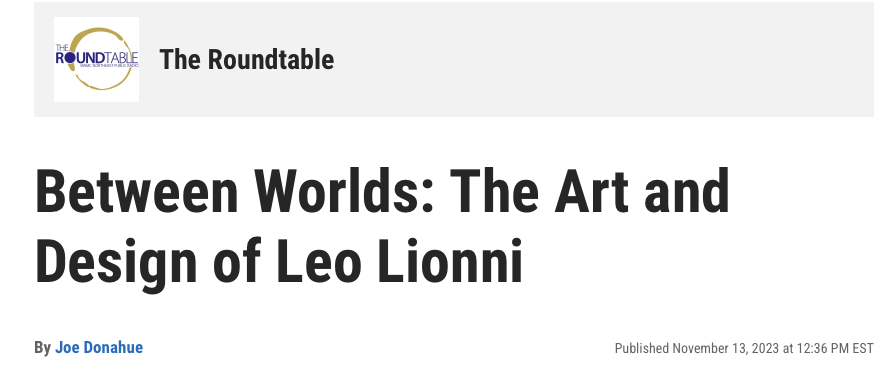
Giuseppe Castellano talks to Stephanie Plunkett, Chief Curator at The Norman Rockwell Museum, Annie Lionni, granddaughter of Leo Lionni, Leonard Marcus, children’s book historian, and Steven Heller, design historian, about how and why they curated Between Worlds: The Art and Design of Leo Lionni; what Lionni was like outside of his work; what creatives today can learn from Lionni’s work and life; and more.
PRESS
Like His Illustrations, Leo Lionni Contained Multitudes
“Twenty-four years after his death, the book lowers the velvet ropes separating the quadrants of Leo Lionni’s creative output. Who knew that the creator of the most recognizable mice since Stuart Little also dreamed up the prototype for Sports Illustrated? … Lionni had a rare ability to change shades—and retain his signature vibrancy—while moving, seemingly effortlessly, from one realm to another.”
‘Leo Lionni’ Review: Design for Adults, Dreams for Children
“Yet for years he remained ambivalent about making children’s books. … Only at 80, Annie Lionni writes, did her grandfather feel secure enough in his legacy to embrace the intertwining of his creative inventions, what she herself now sees as ‘variations on a theme.'”
The Daily Heller: Leo Lionni in Three Acts
A wise man once told me that an artist has at least three acts in their creative lives. Throughout his, Leo Lionni had three major roles that intersect this weekend with the opening of “Between Worlds: The Art and Design of Leo Lionni” (Nov. 18–May 27) at the Norman Rockwell Museum, the Bershires’ hub for illustration.
Norman Rockwell Museum mounts first major American retrospective of Leo Lionni
Stockbridge— On Saturday, November 18th, Norman Rockwell Museum opens the first major American retrospective of artist Leo Lionni, a groundbreaking modernist graphic designer and magazine art director who gained worldwide popularity as the writer and illustrator of nearly 40 children’s books in as many years.
VENUE(S)
Norman Rockwell Museum, Stockbridge, MA November 18, 2023 to May 27, 2024
This exhibition is available to be hosted at your venue. For more information, please contact travelingexhibitions@nrm.org.
DIRECTIONS
Norman Rockwell Museum
9 Glendale Road Route 183
Stockbridge, MA 01262
413-931-2221
Download a Printable version of Driving Directions (acrobat PDF).
Important note: Many GPS and online maps do not accurately place Norman Rockwell Museum*. Please use the directions provided here and this map image for reference. Google Maps & Directions are correct! http://maps.google.com/
* Please help us inform the mapping service companies that incorrectly locate the Museum; let your GPS or online provider know and/or advise our Visitor Services office which source provided faulty directions.


